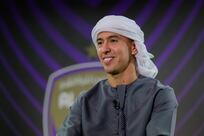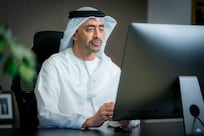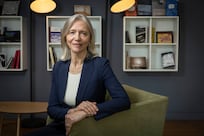To hear him describe it, Owais Husain seems to have been striving to reach this point in his life for many years.
The youngest son of the late Indian master M F Husain, and a prolific artist and filmmaker in his own right, Husain has pursued the life of an artist since childhood – even running away from home at the age of 11 with dreams of becoming a “hermit painter”. It has taken him until now, at the age of 48, to attain the level of freedom he began searching for all those years ago.
Since arriving in Dubai in 2006, he says he has gained a new kind of liberation in his approach to his art and has finally graduated from a process of learning and then unlearning.
“Now I feel that every day is the first day I learnt to paint,” he says. “I don’t mean that I don’t reflect on my life – that is human nature – but now it is not about checking I am going the right way. I am fearless, or perhaps reckless, and every day feels like a new day.”
This kind of abandon is not obvious upon visiting Husain’s studio, which occupies an entire villa in Dubai’s plush Meadows district. The walls are filled with his art, which spans oil paintings, works on paper and photographs.
His latest series – There is no Present, a collection of paintings on handmade paper framed in light boxes – is a stunning example of his work. The pieces are abstract yet figurative, detailed yet sparse, and they play with a sense of scale, leaving the viewer wondering which are the most powerful elements of any given frame.
Husain likes to keep a low-profile, choosing instead to concentrate on producing art and community projects, including work with children in schools in Dubai.
In 2013, he had an exhibition at the Armani Hotel in the Burj Khalifa called Forest of Lost Languages. It featured a collection of paintings that originally showed at New York's Aicon Gallery that explored "the boundaries of forgotten homelands and the wasteland of memories in between".
Last year, in the Capsule Arts warehouse in Al Quoz, his installation Heart of Silence was on show for two months.
It consisted of three paper houses made with wooden frames, filled with light and suspended upside down from the ceiling. Upon them was written his own poetry, as well as that of the English Romantic poet Percy Bysshe Shelley, and each house was reflected in a pool of water beneath it.
Husain chose the form of the house as “a symbol of an intangible sense of identity”, something that is at the heart of his practice. The overall concept was a drive to explore the nature of shifting populations.
“Everyone is an immigrant today – culturally, economically, linguistically and personally,” he says. “Everyone is not anymore where they used to be. We are driftwood, complacent in our ecosystem of misbelief.”
His work is about identity, a sense of displacement and all the chaos that comes with that.
“There is no human that is not touched by this, even in the remotest part of the world,” he says. “Even if they don’t move themselves, they feel the consequences of everyone else shifting in the environment. And because I am interested in this, I couldn’t be in a more appropriate place than Dubai.”
Heart of Silence is catalogued in his newest publication of the same name, due for release at the end of this month.
Its launch is planned for Abu Dhabi Art week and marks Husain’s re-emergence into the public eye.
He is editing a documentary dedicated to his father, titled Letters to My Son about My Father. He started working on it after the artist's death in 2011 and plans to complete by next year.
There are also collaborations with students at art schools across the region.
“I am not burdened or pushed into a direction here in Dubai – rather I am influenced by what I see around me, such as transience and heavy traffic of movement,” he says.
“It is like mercury, it is hard to define but it has seeped into my work over the last nine years since I have been in Dubai – and that is something fabulous.”
artslife@thenational.ae





